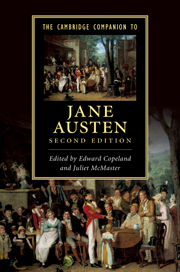Book contents
- Frontmatter
- 1 The Professional Woman Writer
- 2 Northanger Abbey And Sense And Sensibility
- 3 Pride And Prejudice And Mansfield Park
- 4 Emma And Persuasion
- 5 The Early Short Fiction
- 6 ‘Lady Susan’, ‘The Watsons’ And ‘Sanditon’
- 7 The letters
- 8 Class
- 9 Money
- 10 Making a living
- 11 Gender
- 12 Sociability
- 13 Jane Austen and literary traditions
- 14 Jane Austen on screen
- 15 Austen cults and cultures
- 16 Further reading
- Index
- Cambridge Companions to . . .
10 - Making a living
Published online by Cambridge University Press: 28 March 2011
- Frontmatter
- 1 The Professional Woman Writer
- 2 Northanger Abbey And Sense And Sensibility
- 3 Pride And Prejudice And Mansfield Park
- 4 Emma And Persuasion
- 5 The Early Short Fiction
- 6 ‘Lady Susan’, ‘The Watsons’ And ‘Sanditon’
- 7 The letters
- 8 Class
- 9 Money
- 10 Making a living
- 11 Gender
- 12 Sociability
- 13 Jane Austen and literary traditions
- 14 Jane Austen on screen
- 15 Austen cults and cultures
- 16 Further reading
- Index
- Cambridge Companions to . . .
Summary
Jane Austen came from a family who among them followed several of the professions then open to members of the gentry. Her eldest brother, like her father, was a clergyman; another became an army agent and banker before he took holy orders; and her two youngest brothers went into the navy. Only the third brother, Edward, having been adopted as heir to a distant cousin of Mr Austen, inherited landed estates and enjoyed an independent income. So when creating the characters with whom her fiction principally deals – those of the leisured class – Jane Austen would have had plenty of examples in her own family of people who could by no means take an income for granted.
It would be wrong to assume that in the highest levels of the society she portrays nobody actually works. A large estate does not run itself; and the number of people who are dependent on the landowner for their own livelihoods brings a degree of social and moral, as well as economic obligation. When Mrs Reynolds describes Mr Darcy as ‘the best landlord, and the best master ... that ever lived’ and says that there is ‘not one of his tenants or servants but what will give him a good name’ (PP 3:1:276) she is testifying not only to his personal qualities but also to his diligence in ensuring that Pemberley provides a secure income not just for himself but for everybody who works there.
- Type
- Chapter
- Information
- The Cambridge Companion to Jane Austen , pp. 144 - 158Publisher: Cambridge University PressPrint publication year: 2010



